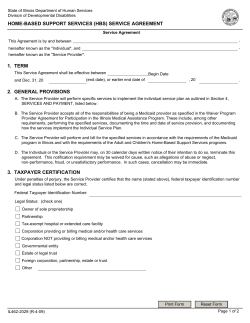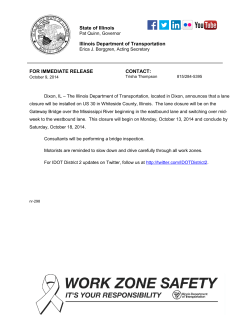
A FOOD AND AGRICULTURE ROADMAP FOR
A FOOD AND AGRICULTURE ROADMAP FOR ILLINOIS MAY 2015 | OVERVIEW FARM Illinois (Food and Agriculture RoadMap for Illinois) is the result of a nine-month effort to develop a comprehensive and integrated strategic plan to ensure sustained and innovative statewide leadership across the entire food and agriculture system. The plan evaluates the system’s current performance and recommends clear goals, strategies, and policy improvements that will position Illinois and the Chicago region as leaders in food and agriculture system innovation. The plan also aims to ensure the state’s leadership in sustainably meeting the 21st-century challenge of global and local food security. WHY ILLINOIS? Food and agriculture’s impact on the Illinois economy 1 of every 17 jobs 9.6% of the state’s economic output, totaling Illinois has nearly Unique proximity of farmland to Chicago, 27 million a global acres of farmland; magnet the state ranked 3rd among US states in 2007 by total acres of prime farmland 106,000 acres of farmland are dedicated to specialty crops, which generated $470 million for world-class in sales for Illinois businesses, institutions, farmers in 2012 and universities $120.9 billion in 2012 Major hub for transportation (rail, water, highway, air) that connects Illinois’ food and agriculture system with the rest of the world FARM Illinois’ strategic recommendations are grouped into six categories that address the full scope of food and agriculture in Illinois. LEADERSHIP FOR INNOVATION GOAL Develop an integrated, statewide, long-term, public-private strategy for achieving the goals of FARM Illinois. BUSINESS DEVELOPMENT AND ENTREPRENUERSHIP Strategies Establish the Illinois Council for Food and Agriculture to spearhead ongoing strategic development and implementation of FARM Illinois Host a Global Food and Agriculture Symposium starting in 2018 to establish Chicago and Illinois as global leaders in addressing 21st-century food and agriculture issues Promote food and agriculture system innovation through multidisciplinary research and policy development Support initiatives to strengthen the roles played by the Chicago region and the State of Illinois in local and regional food and agriculture systems Strategies Improve the state’s business climate to attract, nurture, and retain farmers and food and agriculture companies GOAL Spur business growth and investment by making Illinois the preferred destination for food and agriculture companies of all sizes. Expand financing opportunities and information for farmers and entrepreneurs throughout the food and agriculture system WORKFORCE AND EDUCATION Strategies GOAL Develop a high-quality workforce for food and agriculture and educate Illinois policy makers and the general public on sector innovation. Increase the emphasis on food and agriculture in primary and secondary education Develop a succession planning strategy to retain talent and economic activity in farms and communities throughout the state Establish and enhance food and agriculture clusters across the state Support entrepreneurs and attract investment to food and agriculture Ensure that Illinois’ labor pool is sufficient to serve the food and agriculture system Establish a higher-education food and agriculture consortium to attract the best student talent, strengthen programs, and eliminate duplication Build awareness of Illinois’ food and agriculture system Nation-leading food and agriculture output 1st in the country for soybean production 2nd for corn production 4th for hog inventory and sales 1st for processed food sales biotechnology and agroecology research and innovation Illinois is a leader in Illinois has long been a leader in food and agriculture. However, the state cannot rest on its impressive laurels. The evolution in the global food and agriculture system will require coordinated leadership to foster new understanding, new approaches, and new cooperation if Illinois is to not only remain competitive but also seize the reins and lead that change. The FARM Illinois recommendations address the overall well-being of the state through the application of economic development, community health, and environmental sustainability. Sources: Decision Innovation Solutions, Dun & Bradstreet, United States Department of Agriculture RESOURCE MANAGEMENT GOAL Ensure that Illinois is sustainably protecting and managing its natural resources. Strategies Support existing efforts to encourage sustainable production, increase resilience to climate change, and reduce nutrient runoff Demonstrate demand for existing Federal Farm Bill programs and establish new farm protection programs to preserve farmland Reduce significant waste streams all along the food and agriculture system value chain, including cutting the amount of food waste from farm to fork Promote renewable energy development and energy-saving efficiencies INFR ASTRUCTURE GOAL Ensure Illinois’ infrastructure is capable of supporting the state’s ability to sustainably meet its own needs while being a global leader in food and agriculture. Strategies Improve resource allocation by adopting a comprehensive, intermodal, and multijurisdictional approach to planning and investment Modernize transportation infrastructure vital to agriculture and food distribution Promote the growth and development of the region’s transportation and logistics business sector Enable every household and business in the state to connect to broadband service BR ANDING AND MARKET DEVELOPMENT Strategies GOAL Develop larger and more diverse local, regional, national, and international markets for Illinois’ agriculture and food products by raising Illinois’ profile. Create an Illinois “brand,” inclusive of the food and agriculture system, and implement a strategic marketing plan Raise Illinois’ profile to boost domestic markets and increase exports for the full range of food and agriculture products NEXT STEPS The strategies and recommendations outlined by FARM Illinois will require immediate attention to ensure their success. As a continuation of FARM Illinois, the Illinois Council for Food and Agriculture will represent all stakeholders of the food and agriculture sector, including but not limited to nonprofit organizations, state agencies, trade associations, commodity groups, and research and education institutions. The council, which will serve as an independent umbrella organization, will set priorities, develop performance measures to track and evaluate progress, and update the plan as needed to ensure it remains current and relevant. What will that success look like? Illinois will be the world’s most admired and sought-after destination for food and agriculture businesses from around the world. Food and agriculture in Illinois will increase its contribution to the state’s economy, creating thousands of new jobs for its residents and attracting highly qualified workers to the state. Illinois will be the global pacesetter for basic and applied research in food and agriculture through innovations drawn from bioscience, digital technology, agroecology, and other fields. Illinois farmers and food businesses will expand their already substantial role in global food security through innovation that increases yields, enhances nutrition, conserves resources, and adapts to the changing climate. Illinois’ regional and local food and agriculture systems, especially that of the Chicago metropolitan region, will be among the most diverse and vibrant of any area in the world, set new standards for how food and agriculture can improve health and the environment, and help underserved communities thrive. Illinois’ agriculture infrastructure will be among the best in the world, employing new technologies and creative financing to become a global model. Defining “the food and agriculture system” For this effort, “the food and agriculture system” is defined as a highly complex and interconnected web of activity encompassing all parts of the value chain in food, agriculture, and related industries, including: The production of commodity, specialty, and other crops and the raising of livestock The processing, manufacturing, and retailing businesses and knowhow to take food and agriculture products to markets locally and around the world The physical, business, regulatory, and social infrastructure required to produce and move food and agriculture products to traders, processors, and manufacturers The financial infrastructure and services required to support development in food and agriculture–related activities The human capital, science, and policy that support innovative, efficient, and sustainable food and agriculture production The Searle Funds at The Chicago Community Trust generously provided lead funding for development of this report, with additional financial support from the following organizations and businesses: 1st Farm Credit Services, Archer Daniels Midland Company, Chicagoland Chamber of Commerce, CME Group, Evans Food Group, Farm Credit Illinois, Fresh Taste, GROWMARK, Inc., Illinois Biotechnology Industry Organization—iBIO ®, Illinois Corn Marketing Board, Illinois Farm Bureau, Illinois Soybean Association, Ingredion, The Maschhoffs, Renew Moline, Inc., and United Airlines. For the full report, visit www.farmillinois.org For more information, email info@farmillinois.org. Copyright © 2015 FARM Illinois. All rights reserved. Photography © Courtesy of 1st Farm Credit Services; Henryk Sadura, Thinkstock; Liberty Prairie Foundation; Archer Daniels Midland Company; David Riecks, University of Illinois
© Copyright 2025









